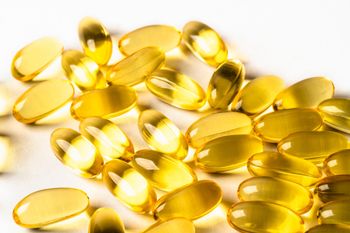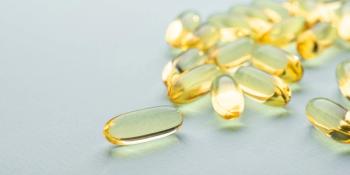
AREDS II Trial Under Way
One of the most important studies on natural ingredients of the past decade will soon have a postscript. The Age-Related Eye Disease Study (AREDS), published in the October 2001 issue of Archives of Ophthalmology, was the first large-scale clinical trial to confirm that antioxidant supplementation may help slow down the progression of advanced age-related macular degeneration (AMD).
One of the most important studies on natural ingredients of the past decade will soon have a postscript. The Age-Related Eye Disease Study (AREDS), published in the October 2001 issue of Archives of Ophthalmology, was the first large-scale clinical trial to confirm that antioxidant supplementation may help slow down the progression of advanced age-related macular degeneration (AMD).
Conducted by researchers from the National Institutes of Health’s (NIH; Bethesda, MD) National Eye Institute, AREDS found that supplements containing a mixture of vitamins C and E, beta-carotene, and zinc lowered the risk of advanced AMD by 25% in people at high risk of developing the condition; the supplements had no observable effect on people who had no AMD or were in the early stages of developing it.
One of the drawbacks of the original AREDS trial was that, while it did examine the effects of antioxidants on AMD, it did not study other nutrients, such as lutein, zeaxanthin, and the omega-3 fatty acids eicosapentaenoic acid (EPA) and docosahexaenoic acid (DHA). Since 2001, more epidemiological evidence has come to light suggesting that these other nutrients may play a role in eye health.
Now, researchers at the National Eye Institute are working on a follow-up to the AREDS study. AREDS II picks up where the original trial left off, assessing the effects of lutein, zeaxanthin, DHA, and EPA on AMD. While the main focus of AREDS II will be on eye conditions such as AMD and cataracts, NIH researchers also hope to learn more about the effects of EPA and DHA on cognitive function.
“We are excited to start a new trial to evaluate nutritional supplements, lutein and zeaxanthin, and omega-3 fatty acids for the treatment of AMD,” says Emily Chew, MD, deputy director of the division of epidemiology and clinical research at the National Eye Institute.
“We will be recruiting 4000 patients nationwide in ophthalmologists’ offices, in both academic centers and private practices,” explains Chew, adding that the National Eye Institute will collaborate with other institutes and pharmaceutical companies on the project.
AGE-RELATED MACULAR DEGENERATION AND CATARACTS
AMD is one of the leading causes of visual impairment in the United States. According to the National Eye Institute, about 1.7 million Americans have some form of AMD, a disease of the macula that blurs the sharp, central vision needed for many common activities. The National Eye Institute notes that AMD has caused about 100,000 cases of blindness in the United States.
There are two forms of AMD: wet and dry. Wet AMD, which is caused by leaky blood vessels behind the retina, is considered advanced-stage AMD, while dry AMD happens slowly over time as light-sensitive macular cells break down. There are several stages of dry AMD, including early, intermediate, and advanced AMD.
Dry AMD is more common than wet AMD, but wet AMD is usually more severe. More than 85% of people with intermediate and advanced AMD have dry AMD, but nearly two-thirds of all patients with advanced AMD have the wet form. Most vision loss comes from advanced AMD.
Another leading cause of visual impairment, cataract, is caused by clouding of the lens in the eye. Cataracts can be treated successfully with surgery. According to the National Eye Institute, doctors perform more than 1.5 million cataract surgeries each year.
THE AREDS LEGACY
In the AREDS trial, people at high risk of developing advanced AMD who took a combination of antioxidants lowered their risk of the disease by 25%, and people with intermediate AMD who took the supplements reduced their risk by 19%. However, the AREDS supplements had no observable effect on people who either did not have AMD or who were only in the early stages of the disease. The supplements also had no significant effect on the development of cataracts. Bausch & Lomb (Rochester, NY) manufactured the supplements, which contained 500 mg of vitamin C, 400 IU of vitamin E, 15 mg of beta-carotene, 80 mg of zinc oxide, and 2 mg of cupric oxide.
Aside from its contribution to the study of eye health, AREDS also did something else-it helped put eye health supplements on the map, according to Robert Baily, global marketing manager at Cognis Nutrition & Health (La Grange, IL). “When a large, government-funded study on the scale of AREDS finds that a supplement can potentially help 300,000 people, consumers pay attention,” Baily says.
“AREDS helped tremendously to increase awareness of AMD among the general public and helped fuel the momentum behind sales of eye health supplements, even if it did not include lutein and zeaxanthin, which were still not available commercially at the time the study was planned,” agrees Manual Pavon, general manager at Chrysantis (West Chicago, IL).
The new AREDS II study promises to do the same, and it should increase awareness of lutein, zeaxanthin, and omega-3s. The new trial is particularly exciting because it takes into account epidemiological evidence that was discovered after the original study took place.
“AREDS II is important because it recognizes the pertinence of the body of scientific evidence collected over the last 10 years on the potential benefits of both lutein and zeaxanthin,” says Pavon. “We believe AREDS II could get the medical community off the fence when it comes to recommending lutein and zeaxanthin eye health supplements.”
LUTEIN AND ZEAXANTHIN
Two important nutrients that weren’t included in the original AREDS study are lutein and zeaxanthin. Lutein and its isomer zeaxanthin are both found in the retina, but while lutein exists mostly in the macula at the center of the retina, zeaxanthin exists mainly in the retina’s peripheral zone. Lutein and zeaxanthin may play a protective role in vision by shielding the eye’s components from oxidative stress and light.
“Deposits of lutein and zeaxanthin form the macular pigment in the eye’s retina,” explains Baily. “This tissue, with its normal carotenoid deposit, aids detailed vision, and by filtering out harmful blue wavelengths of light, may protect the underlying eye components.”
A greater density of macular pigment is associated with a greater likelihood of maintaining healthy vision, Baily notes, adding that lutein and zeaxanthin may also help reduce the levels of damaging free radicals in the eyes.
“Most of the epidemiological evidence suggests that both lutein and zeaxanthin help prevent AMD,” Pavon says. “Some very preliminary evidence suggests also that higher dosages of these carotenoids might be able to stop AMD from advancing from phase I to more damaging stages.”
Astaxanthin May Protect Against Eye Strain
While many scientists have been studying the effects of nutrients on age-related macular degeneration, researchers at Toyama Medical and Pharmaceutical University in Japan have explored a different angle-how carotenoids can protect against eye strain.In a 2002 study, the Japanese researchers gave 5 mg per day of astaxanthin derived from Haematococcus pluvialis to 13 video display terminal workers, who often suffer from eye strain, for four weeks. Another 13 video display terminal workers received a placebo. In addition, the researchers recruited 13 people who didn’t use video display terminals as a control group. To assess eye strain, the researchers measured several variables, including accommodation amplitude.
Although all of the video display terminal workers had complained of eye strain before the study began, only 54% of the treatment group still reported eye strain after the study, compared with 92% of the placebo group. “Although the exact mechanism remains unclear, it is likely that antioxidant activity of astaxanthin may be involved in improvement in accommodation amplitude in video display terminal workers,” according to the researchers.
Fuji Chemical Industry Company, Ltd. (Toyama, Japan), supplied the astaxanthin used in the study.
Two key studies on lutein were published in 2004 and 1994. In the April 2004 issue of Optometry, Stuart Richer, OD, PhD, and colleagues from the Department of Veterans Affairs Medical Center Eye Clinic (North Chicago, IL) found that lutein, alone or in combination with antioxidant vitamins and minerals, improved mean eye macular pigment density, visual acuity, and contrast sensitivity. In Richer’s study, known as the Lutein Antioxidant Supplementation Trial (LAST), 90 AMD patients received either 10 mg of lutein, 10 mg of lutein plus additional antioxidants, or a placebo, for 12 months. Richer concluded that “visual function is improved with lutein alone or lutein together with other nutrients.”
The other study, published in the November 9, 1994, issue of the Journal of the American Medical Association, evaluated the relationship between dietary intake of carotenoids and the risk of AMD. In that study, Joanna Seddon, MD, and colleagues from the Massachusetts Eye and Ear Infirmary’s (Boston) epidemiology unit found that a high dietary intake of carotenoids was associated with a lower risk for AMD. Specifically, those in the highest quintile of carotenoid intake had a 43% lower risk, compared with those in the lowest quintile. Moreover, among all of the carotenoids, lutein and zeaxanthin were the most strongly associated with a reduced risk for AMD.
“Science has linked lutein and zeaxanthin with reducing the risk of AMD among people over 50 in developed nations,” says Zoraida DeFreitas, PhD, vice president of research and development at Kemin Health (Des Moines, IA). “Dr. Richer’s study and AREDS established the concept of AMD as a nutritionally responsive condition.” According to the National Eye Institute, an inverse relationship of dietary omega-3 intake with advanced AMD has also been reported in all studies examining the issue.
Despite the growing body of evidence that lutein and zeaxanthin may help protect vision, many people don’t eat enough fruits and vegetables to reach optimal levels of the nutrients. Some epidemiological studies suggest that 6–20 mg per day can protect against AMD, but the mean intake of lutein, according to the 2001 Dietary Reference Intake report from the National Academy of Sciences (Washington, DC), is only 1.7 mg per day.
“Studies continue to show a dietary gap among Americans,” notes Cognis Nutrition and Health’s Baily. “Most adults do not consume the recommended daily servings of fruits and vegetables, so supplementation can help bridge the gap. Also, the body does not produce lutein, which is another reason why supplementation is prudent.”
EPA AND DHA
Another two nutrients that weren’t included in the original AREDS trial are the omega-3 fatty acids DHA and EPA, which have long been recognized as essential components of neural development. In January 2005, researchers from the National Eye Institute published a review in Progress in Retinal and Eye Research that explored the effects of omega-3s on health and disease of the retina.
The National Eye Institute researchers listed several possible protective mechanisms associated with omega-3s, including their ability to modulate metabolic processes and attenuate environmental exposure to light, stress, inflammation, and other factors. The researchers also noted that DHA is a major structural lipid in retinal photoreceptors, and that DHA insufficiency in retinal tissue is associated with alterations in retinal function. EPA also plays a role in various processes within eye tissues.
Because the extent of DHA and EPA’s protective effects, if any, are still unknown, future studies involving these nutrients could be valuable to researchers.
AREDS II: THE NEXT PHASE
The newest phase of the National Eye Institute’s research program, AREDS II, is scheduled to conclude by July 2007. The new trial will be a multicenter, randomized study of 4000 participants aged 55 to 80 who have large drusen (yellow deposits under the retina) or advanced AMD in one eye.
Participants will receive supplements containing either a placebo, 10 mg of lutein plus 2 mg of zeaxanthin, 1 g of DHA and EPA, or all four nutrients. In addition, the researchers also plan to evaluate a new version of the original AREDS formula. The original supplements contained beta-carotene, which is potentially harmful to smokers, and zinc, which caused urinary tract problems in some patients.
“We have taken information learned from the original AREDS to test whether these other factors may make a difference in the prevention of AMD,” explains the National Eye Institute’s Chew. “We will also be refining the original AREDS formulation by testing the elimination of beta-carotene and/or reducing the level of zinc.”
While some ingredient manufacturers would have liked to see higher doses, or perhaps different ratios, of lutein and zeaxanthin, most are confident that the results of AREDS II will support the effectiveness of these nutrients. As the evidence continues to roll in, and as the population continues to age, the industry expects interest in eye health supplements to continue.
“For Kemin Health, 2005 was a solid year, continuing an upward trend that began 10 years ago,” says DeFreitas. “The first two months of 2006 are showing continued growth over the prior year. We have to think this signals continued growing demand for eye health products.”
“We strongly believe that lutein ingredient quality, safety, and consistency will become a bigger factor for lutein-centric products as new vitamin and dietary supplement good manufacturing practices are implemented, and as demand for demonstrable quality builds from physicians, optometrists, pharmacists, and other influencers,” continues DeFreitas.
Cognis Nutrition and Health’s Baily concurs. “As the population ages, we can expect to see even more interest in eye health ingredients,” he says. Baily notes that the syndicated health writer Jane Brody recently devoted an entire column on AMD and vision loss.
“Consumer demand for eye health supplements will grow as more eye health professionals learn about their benefits, and as the Jane Brodys of the world help us inform the public,” Baily says. “Eye health products that are natural, safe, and affordable, and that offer protection to an aging population, are sure to be successful.”
Newsletter
From ingredient science to consumer trends, get the intel you need to stay competitive in the nutrition space—subscribe now to Nutritional Outlook.





